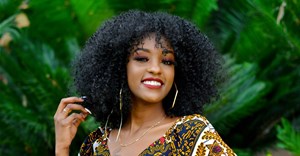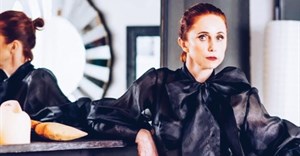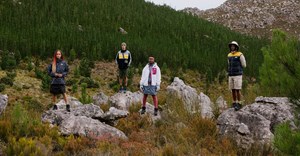The Goddesses of the past and present (Part 1)

But here I’m going to focus on Edelkoort’s insights into the trends for spring/summer 2019 and why this year she looked to the ‘goddesses’ of the past to define the women of today.
“It’s about the situation of women in today’s society,” she explains...
The book builds on from a previous one about emancipation in which she forecasted that everything would emancipate, that there would be a new role for both the young and old, especially men who are becoming much more concerned about domestic issues. “This leaves women sort of puzzled,” she says, saying that women are in turn becoming a species that don’t know exactly where they are, who they are, what is going to happen or what they will be in the future.
So, she decided to go deeper into the woman’s psyche to research what is going to happen. She took inspiration from Jean Bolen’s Goddesses in Everywoman: Powerful Archetypes in Women's Lives and also looked at several archetypes of goddesses from all continents, so it’s a global situation, she says. “I used the goddesses as inspirational tools to see what is happening to us women and it has been a journey of sorts…”
Mother Earth
“I had to start with Mother Earth because we are so concerned about the earth and the nourishing aspect of Mother Earth is inherent in all females.” The beautiful, prehistorical female representations of the female form have been and will be very generous, and this is a reminder for the industry that we cannot continue to use the same patterns and need to look at new pattern-making, she suggests.
Mother Earth is down to earth, routed, and this suggests that… wait for it… we will be walking in flat shoes. The flat shoe of the moment is the babouche, which is actually a Muslim shoe.
These trends are about fashion and textile, and this one, in particular, suggests earth dying and earthy fabrics and fibres such as linen, cotton and pure wool. Her colours are earthbound neutrals, and importantly, they don’t have to be dark. These women want roomier, easier, simpler clothes, such as the sack dress, which is “the archetypal dress we will see become the bestseller dress of the summer seasons to come”, says Edelkoort. It’s basically just a men’s shirt and large to the extreme. The one she showed us had a long panel and a V-neck, but it doesn’t have to have a V-neck, it can take on all sorts of detailing, she explained. Very important, however, is the cloth belt. And as this is very much about generosity and taking care, we will also see natural drape, she says, not so much the Olympic drape, but one that’s more rough and ready.
Athenae
Athenae was born as a mature girl. She is the most intellectual woman. She knows where she’s going and is very dedicated. She is very much at ease amongst men, so she’s like a man amongst men and has more male characteristics than any other archetype. So, she’s a diplomat, a politician or a CEO, says Edelkoort.
As such, Athenae loves neutrals and loves to be in neutral territory. She has no fear and is also defensive, so she likes armour and armour-inspired fabrics that are woven, quilted or stitched. Like Mother Earth, she is also dressed in longer, easier dresses with drawstrings – sometimes two pieces – and the length is very important, believes Edelkoort. She is also wise, like her favourite bird, and has a nose for business and for arts and crafts, so there’s an artistic side to her as well.
Bastet
Another very interesting character is Bastet from Egypt – the goddess of cats. Edelkoort told the story: “Her temple is in the middle of the Nile, and it is a round temple, and under the temple, under the ruins, they have about 7,000 cats buried, mummies of cats, because rich families would bring their dead cats to the temple to be under her main.” Cats were particularly celebrated in this period, but even to this day in Muslim countries because of Mohammed’s affection towards them.
Bastet is a cat woman, a sort of dancer archetype with little hands and a high neck. She is haughty and very elegant, flexible and very supple. Like a dancer, she has a beautiful pace. There’s a strength, elegance and distance in this person. So, this is about elegant dressing and small hairdos. There’s lots of pleating going on and beautiful colours, like the popular-to-be yellow-green, “something between an avocado and wasabi,” Edelkoort explains.
Very important here in this whole book, in the whole situation of the season is accessories, flat shoes and long earrings, so in fact, you can resume the whole fashion to a little hat, earrings, a sheet of colour or material and flat shoes, and that’s it.She is also the spokesperson of fragrances. Alabaster is taken from her name, which contains fragrant ointments, so Edelkoort says she finds it bizarre that no fragrance has ever used Bastet as an icon, especially given how popular cats are today.
Hestia
Another very popular archetype for both men and women is Hestia, a romantic soul with a caring character. “This archetype loves making house, cleaning, ironing, wiping, cooking, taking care of the chickens, taking care of the dog – just in and around the house. She doesn’t need anyone else, she can have somebody and she can have friends over, she can have a man or a partner – a bit like having a dog, yeah, I mean, very nice and comfortable – but it’s not a sort of regular relationship. She is happy just in her own self.”
This woman is always grasping for medium, dense colours, and she loves denim, but romantic denims. “The dresses are almost sort of symbolic dresses of the caring and the householding. They’re like maid’s dresses, and we will see a lot of bonnets, and the textiles will be inspired by the household textiles, so household linen textiles and food is a very big aspect here.”
Persephone
Persephone is another very current character. The princess doll we see in society so much highlighted so much by the ‘it girls’ and Instagram and so on. “She is the symbol of eternal spring because she comes from the underground back in spring, and she is always springy and fresh and she will stay fresh all her life.”
She is young in her whole being, but she’s also a bit sad because she doesn’t really know where to go in life. “She’s always searching for things, always looking for things, always hunting for a prince which will never come, the frog will not turn into a prince, and she’s also looking for sugar daddies and they’re not here anymore either, so she is maybe the most vulnerable suffering from the new male archetypes, because there is just no longer this man.”
She is keen on beautiful things and she’s collecting bijouterie and shoes like crazy. “Of course, she wears beautiful, very delicate fabrics, she loves soft, transparent colours, such as pinks and violets and so on.” Because she spends half her time in the underworld, there’s also a sort of naughty, dark side to her, so her style is also a bit punky.
Aphrodite
Then there’s Aphrodite which is also for all of us: men, women and even animals, as we all fall in love and know the feeling of having ‘butterflies’ in your stomach and wanting to speak about someone all the time.
“Aphrodite was born from the cut-off genitals of her father mixed with the foam of the sea, so she loves foaming materials, foamy and frothy and tulle, layers and frills.”
It was a few years ago, I think six or seven years ago that we did a book called Gathering, which was about how fabrics would be gathered into pleats, into stitching, into frills, and I then said I’m thrilled to say that frills will come back, because if they come back it means a better economy – so that’s a sign we can always be trusting.
DISCOVER THE NEW SEASON from trendtablet on Vimeo.
She wears frills on her sleeves, pun unintended.
Sleeves as you know are the biggest design focus now, almost too much, but that’s how it is with fashion.She loves pale colours and transparent textiles, and elastic textiles to show the body. Beautiful bijou and multiple bijouets – sometimes it’s not enough to have just long earrings, you also have to have a few clip-ons. A lot of loose ends are still important, so a lot of fringes and ribbons and so on. And again, an amazing layering of frills, and as far as shoes go, the small heel from the 60s will come back, she says.
Demeter
Demeter is about the harvest, the strength and beauty of the harvest, the romantic aspect of the countryside, and that maternal feeling that gives us full and layered high-waisted dresses. It’s all very much about fertility and motherhood. “Here, the fullness is very dominant in giving us new, almost resistant drape.
This woman takes care of her kids so much that she is a bit overbearing. “This is the mother that doesn’t let go, will always come back to you every week to find out if you’re feeding yourself if you are holding up and so on. And she is also, therefore, a very well-known archetype. For her the children are most important, her partner is there to get the children, but then the children take over.”
To continue reading, click here:

About Jessica Tennant
Jess is Senior Editor: Marketing & Media at Bizcommunity.com. She is also a contributing writer. moc.ytinummoczib@swengnitekram














![[Design Indaba 2015] The selfie shapes monolithic fashion](https://biz-file.com/c/1503/262524.jpg)









